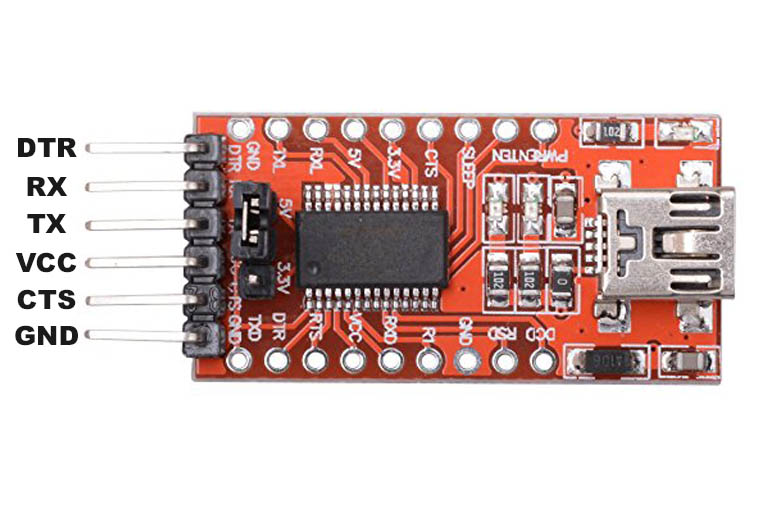The FTDI USB to TTL serial converter module is a UART (universal asynchronous receiver-transmitter) board used for TTL serial communication.
Table of contents
Introduction to the FTDI USB to TTL serial converter module
The FTDI USB to TTL serial converter module is a UART (universal asynchronous receiver-transmitter) board used for TTL serial communication. It is a breakout board for the FTDI FT232R chip with a USB interface, can use 3.3 or 5 V DC and has Tx/Rx and other breakout points.
FTDI USB to TTL serial converter modules are used for general serial applications. They are popularly used for communication to and from microcontroller development boards such as ESP-01s and Arduino micros, which do not have USB interfaces.
- Get the FT232RL FTDI USB To TTL Serial Converter Module from Amazon.com or BangGood
- Get the 6 Pin FTDI FT232RL USB To Serial Cable from Amazon.com or BangGood
- Get the Microelectronics Starter Kit from Amazon.com or BangGood
- Get the Solderless Breadboards (8.5×5.5cm) from Amazon.com or BangGood
- Get the Basic Arduino Uno R3 Starter Kit from Amazon.com or BangGood
FTDI USB to TTL serial converter module
Original FT232R chips are one of the newer chips manufactured by FTDI (Future Technology Devices International). Apart from being a USB to serial UART, it has an integrated EEPROM and optional clock generator output.
The chip also incorporates FTDIChip-ID functionality (giving each chip a unique identifier for security) and USB termination resistors. Cloned boards (with a cloned chip) will likely exclude the unique ID functionality and do not include an EEPROM, meaning that signals cannot be inverted.
The internal clock (6MHz, 12MHz, 24MHz and 48MHz) can be brought out of the device and used to drive a microcontroller or external logic.
The module has a mini-B USB port which is used to connect to a USB port of an interfaced device (e.g. a PC). On the other side, the FTDI USB to TTL serial converter module has breakout pins (Tx, Rx, Vc and GND) that are connected to a microcontroller’s corresponding pins.

The FTDI USB to TTL serial converter module has a Mini-B USB port which is connected to a USB Type-A port on a PC.
Communication takes place using TTL (transistor-transistor logic). It has a 3.3/5V DC jumper and will supply 500 mA through its Vc pin.
FTDI USB to TTL serial converter module specifications
Chip: FT232R (FTDI)
Pins: 6 pin headers and 18 through-hole connectors. DTR, RX, TX, VCC, CTS, GND and PWR, TEN, SLEEP, CTS, 3.3V, 5V, RXL, TXL, GND x 2, TXD, DTR, RTS, VCC, RXD, R1, RSD, DCD (all marked)
Working voltage: 5V DC
Level output: 3.3 – 5 V DC (jumper)
Interfaces: Serial/UART
On-board LEDs: power on, Rx, Tx transmission, working status
Operating current: 500mA
Module size: 36 x 18 mm
Pin size: male, 5 x 2.54 mm
Ports: Micro-B USB
Breadboard friendly: yes
FTDI USB to TTL serial converter module pinout

The FTDI USB to TTL serial converter module pinout. Also, note the 3.3 V / 5V jumper connector for the VCC pin.
The FTDI USB to TTL serial converter module has six, male, 5 x 2.54 mm header pins and 18 through-hole connectors. The header pins are breadboard friendly and all the pins/connectors are clearly marked.
The more commonly used pins (RX, TX, VCC and GND) are connected to the corresponding pins of the microcontroller (RX -> TX and TX -> RX).
The DTR pin is connected to the reset pin of the microcontroller, which will trigger an auto-reset signal after a sketch is uploaded.
Drivers
Some devices might need drivers to register the FTDI USB to TTL serial converter module to be able to appear as a COM port. This allows application software to access the module in the same way as it would access a standard COM port.
Although some operating systems might install the drivers automatically after their first use, others might need these drivers to be installed manually. For more information, visit the official FTDI Virtual COM Port Drivers page.
Conclusion
The FTDI USB to TTL serial converter module is a UART (universal asynchronous receiver-transmitter) board used for TTL serial communication. It is popularly used for communication to and from microcontroller development boards such as ESP-01s and Arduino micros.


Where can we buy these FT232R USB-UART modules from?